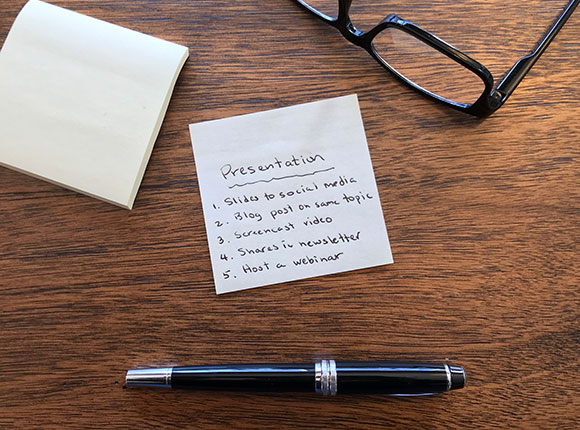Repurposing Content: Think Outside the Box

As marketing and design consultants, we know that businesses and nonprofits of all sizes struggle with generating content for their online marketing efforts. Understandably, it can be a real challenge for business professionals to find the time and ideas for what they can produce as blog posts, videos, or podcasts. Over the years, we have helped a lot of folks expand the value of what they have already created by repurposing content for use and sharing in different ways.

What is Repurposed Content?
Simply stated, repurposed content is information, materials, images, written copy, presentation slides, and more that has been edited and adapted for use in a different way.
For example, an accountancy firm has recently produced an updated print brochure detailing the offerings its provides and the industries it serves. The goal and purpose of that brochure might be to inform existing clients of additional ways in which that accounting firm can be of value. The written content and images from that print brochure can subsequently be used as the basis for updating the services section of the firm’s website, or as a series of blog posts highlighting the different services and industries. In effect, that print brochure has been repurposed as website marketing content.
Use of repurposed content is a great way to get even more value from an editorial calendar.
10 Examples of Repurposing Content
Sometimes the best way to help people understand how they can repurpose their own content is to provide specific examples. With that in mind, we’re sharing 15 examples of repurposing content that you can use to come up with your own. Or rather use our examples and run with that. That’s why we published this blog post – to help you!
Example 1: A Lawyer Gives a Presentation to Her Local Chamber of Commerce
In this example, an attorney spoke for 45 minutes about proposed zoning changes to her local business district.
5 Ways to Repurpose a Single Presentation
- In the days following the presentation, the law firm posts individual slides as images on social media (like LinkedIn, Twitter, and Facebook) along with links to where the full slide deck is available for review.
- A week after the presentation, the lawyer publishes a blog post on the same proposed zoning changes, using her presentation as the basis for the blog post. She incorporates answers to questions she received during the presentation in the blog post.
- A month after the blog post, the lawyer updates the presentation as needed and records a screencast of her talk. The output video is effectively the lawyer’s voice talking over the slides as she clicks through the presentation. The screencast video is posted to YouTube, embedded on the firm’s website, and shared via social media.
- The lawyer writes a two paragraph overview of the key issues in the proposed zoning changes for inclusion in firm’s monthly or quarterly newsletter. The blog post and presentation form the basis for those two short paragraphs. The newsletter includes links to the attorney’s slides, YouTube video, and blog post.
- In the month or quarter following the newsletter, the attorney hosts a webinar for local businesses to better understand the issues around the proposed zoning changes, how it will effect their businesses, and what they need to do legally to prepare for the zoning changes.
Example 2: A Non-Profit Publishes a Progress Report for a Three Year Program
In this example, a nonprofit organization published a progress report detailing the successes and challenges from its program focused on getting local homeless folks into safe housing.
5 Ways to Repurpose a Single Funding Report
- After the draft report is approved by its board, the organization publishes the report in PDF format on its website. In a sentence or two for each, it shares a selection of key wins and highlights some of the more pronounced hurdles to successfully delivering the program.
- Drawing on the relationships of partners mentioned in the report, the organization publishes a blog post about the overnight shelter where many of those in transition to permanent housing stay. The focus is on the folks who run the shelter and the good work that they are doing. Be sure to include a photo or two of the shelter’s facilities and team members.
- Drawing from the content within the report, write a blog post about the good things that the program achieved in its first year. Walk through the factors that led to success. Highlight the team members who made that happen. Share the blog post widely on social media.
- In a newsletter, flag up up the program’s challenges. Draft a short bullet list of fundraising opportunities to which donors can give to enable the program overcome those challenges.
- Using a smart phone, record a short video (less than 2 minutes) of a senior executive at the nonprofit talking through the exciting approach that the organization will take to addressing the challenges set out in the report. Post that video to YouTube, embed it on the organization’s website, and share it widely on social media.
Only the Tip of the Iceberg
The ideas shared in the examples above are only the tip of the iceberg. They are intended as a starting place. Dig deep into your own creativity to come up with your own ideas. Brainstorming how best to reuse or retool your content is a practice that gets easier and more productive with time.
Get Help Brainstorming with Repurposing Content
If you’re struggling to get enough value from repurposing content, we invite to you get in touch. We’d love to hold a brainstorming session with you, to bring our years of experience to your marketing efforts.
[lbdesign_button link=”https://lbdesign.tv/contact/project-request/” new_tab=”false” type=”default” size=”xlarge” style=”default” custom_class=””]Let’s Brainstorm Together![/lbdesign_button]
